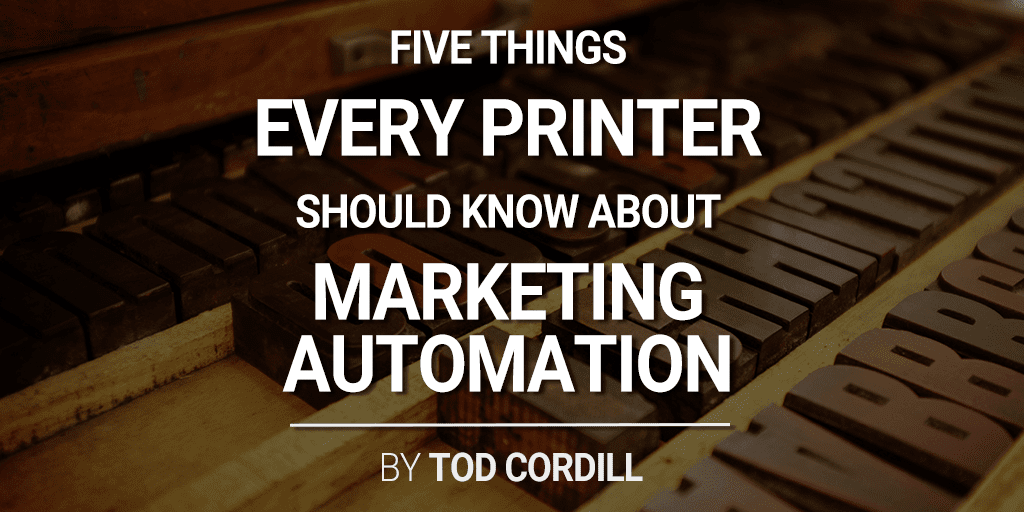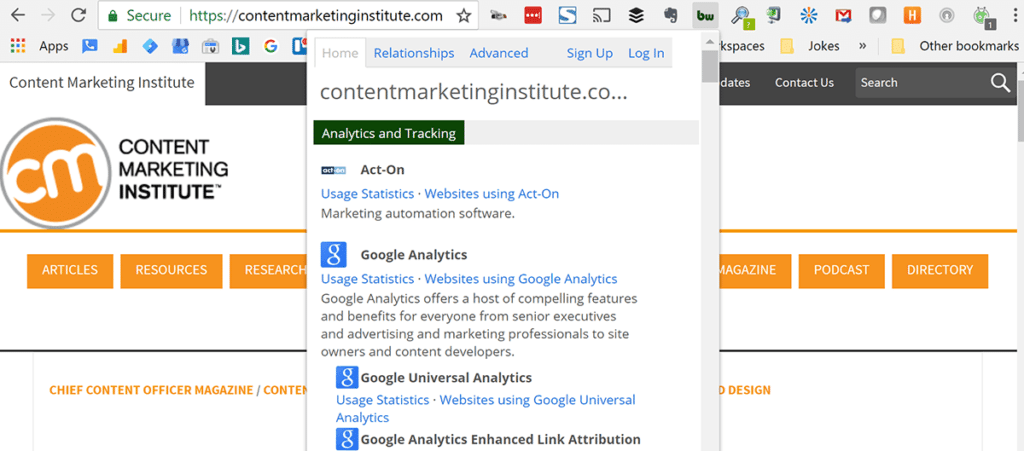
Marketing automation has been a hot topic for years, so why should you care now? Forrester predicts that industry growth for marketing automation platforms will continue at a rapid rate, reaching $25.1 billion annually by 2023 from $11.4 billion last year. (Source: MarTech Today)
This growth is fueled by increased penetration, particularly in mid-sized business, and an increased share of marketing budgets. In 2018 the average company is expected to allocate 41% of their marketing budget to digital, up from just 29% in 2014. By 2020 digital marketing spend is forecast to grow to 45% of the overall marketing budget. (Source: Web Strategies) These are big changes in a short amount of time.
It is more important than ever for printing companies to embrace digital marketing technologies now. This blog post will provide enough information to allow you to discuss marketing automation strategies with your customers and start the discussion on how you can help.
First off, let’s define what we mean by marketing automation.
What is Marketing Automation?
There are several digital technologies that can be considered a form of marketing automation. These include:
- Social media scheduling tools like Buffer and Hootsuite
- Social media sales prospecting tools like Socedo
- Sales prospecting cadence tools like customer.io and SalesLoft
- Behavior-based email marketing tools like Marketo, Act-On and Hubspot
Marketing automation refers to software technologies that enable marketing departments to efficiently communicate with prospects and customers using email and other channels and tailor the messages based on where they are in the buying process and their online behaviors.
Think Marketing Programs, not Campaigns
To effectively use marketing automation you need to think of ongoing marketing programs rather than time-based marketing campaigns.
Time-based campaigns still have their role. Examples include event marketing where you’re trying to drive people to attend an event at a specific time. You may also have seasonal campaigns that help generate leads or get prospects closer to buying.
But most of your marketing investment should go to ongoing marketing programs. The reason is that you need to provide messages that are relevant for the role of the individual person as well as where they are in their customer journey.
You hopefully have prospective customers that are in all stages of their journey to become a customer. Some have just started researching to learn how to solve problems, some have heard of your company, some have become quite familiar with what your company provides, and your sales team is likely talking to some that may be signing their first P.O. very soon. Then there are existing customers that are an opportunity for buying additional services from you.
You just can’t create a time-based marketing campaign that will be relevant to all these audiences.
Ongoing marketing programs are the answer. Define the roles of the people that are involved in finding and approving your services. Determine the different types of information they need as they’re going through their Awareness > Consideration > Decision journey.
The Customer Journey

Content created for each role and each stage of their customer journey can be delivered using marketing automation tools.
Deliver a Relevant Message
The goal is to deliver the right message to the right person at the right time. There are several ways marketing automation tools help enable this.
A classic marketing automation use case is trading a white paper for an email address. A prospect lands on your blog and finds some useful information with a link to a white paper with more details. Or maybe they responded to a Google AdWords advertisement and landed on your white paper landing page. For the mere price of entering into a form their email address, and maybe a few other bits of information, they can get the white paper that will provide information that helps them along their customer journey.
The form, and maybe the landing page was built in or integrated with a marketing automation platform. The platform sends the first email right away with a link to the white paper. A few days later you can send a follow-up email with links to other information for the prospect’s current customer journey stage as well as the next stage. If they don’t respond the platform might follow up a week or two later, or maybe a sales development rep follows up with a phone call.
Other similar marketing automation programs can be used for:
- Webinar signups
- Email newsletter signups
- Shopping cart abandonment
There’s something really great about knowing who your prospect is and where they are in their buying process. You can deliver a concise message that is relevant. No more two-page prospecting emails that you hope has some piece of information that your prospect finds useful. (Even if it’s there they won’t take the time to find it.) Instead, you deliver a useful message that in a couple of short paragraphs the reader can quickly scan, determine it is relevant, and respond to the call to action.
Know Your Visitors
A very powerful use of marketing automation software is obtained by adding a beacon or tracking javascript code, to your website. This software tracks what pages individual visitors are viewing.
Once you know who your individual visitors are the technology can track what they are interested in and how frequently they visit your site. The beacon allows you to track each page view, email open and click white paper download, and video that they view.
Marketing automation platforms allow you to assign scores to each asset that your site visitors or email recipients view. Your website visitor gets a lead score that indicates their interest level in your services. Some software allows you to create different types of scoring systems. Multiple scoring criteria allow you to:
- Role-based scores where executives or other key decision makers score high.
- Journey scores that indicate where the person is in the Awareness > Consideration > Decision customer journey.
- Interest scores where you assign categories and scores to different web pages or other assets. An interest score can indicate the types of services, such as collateral, direct mail, or retail graphics the visitor is interested in.
What enables this is to turn your anonymous website visitors into known visitors. The two ways a website visitor typically becomes known is by filling out a form on your website or clicking on a link in an email generated by the marketing automation system. Because of this I always recommend guiding website visitors to fill out a contact us form rather than an email link.
Integrate Print Into Marketing Automation
Now that you know what your customers are doing with marketing automation technologies you can start to speak to how you can work with them to help them obtain their goals.
Rather than pitching direct mail programs, sales collateral, and other materials as separate marketing tools you can discuss how they can work with their existing programs.
Here’s a tip on how to prepare for this discussion. There are browser plugins that show you what technologies are used on a website you’re viewing. Two plugins I’ve used for this are BuiltWith and Ghostery. From this screenshot, you can tell that Content Marketing Institute uses Act-On as their marketing automation program.

My next Print Media Centr blog post will describe several ways that print can be integrated into marketing automation programs. If you’d like to get a head start you can check out this Integrating Marketing Automation with Print SlideShare presentation.















3 Responses
You guys often shared great and informative posts. I work at a printing company in Dubai and I learned lots of thing from you.
Keep doing great work
Medium-sized companies highly depend on digital marketing to ensure their sales. Therefore, marketing efforts need to be highly efficient in order to drive the business growth for which marketing automation can be immensely productive. This article refers to all those technologies and measures for this technique so, thanks for posting it and keep it up.
Nomi and PlusPrinters, thanks for the kind comments.
I believe we’ll be seeing a lot more about direct mail being leveraged as another channel in marketing automation platforms over the next few years.